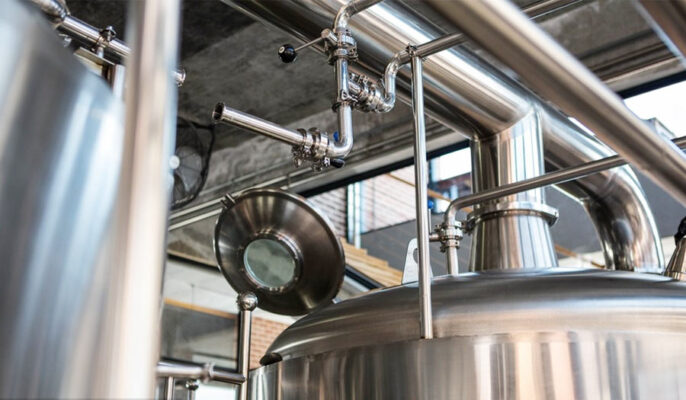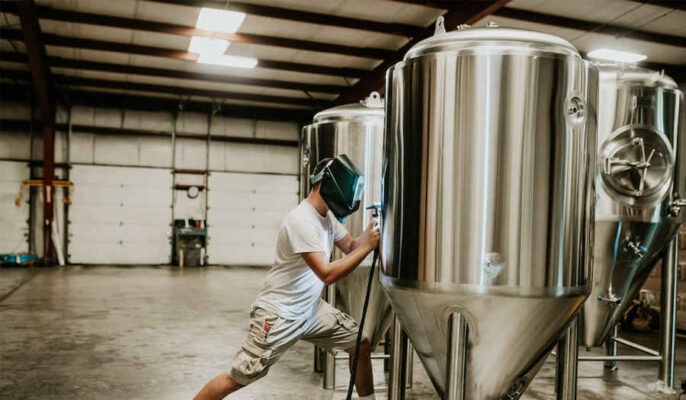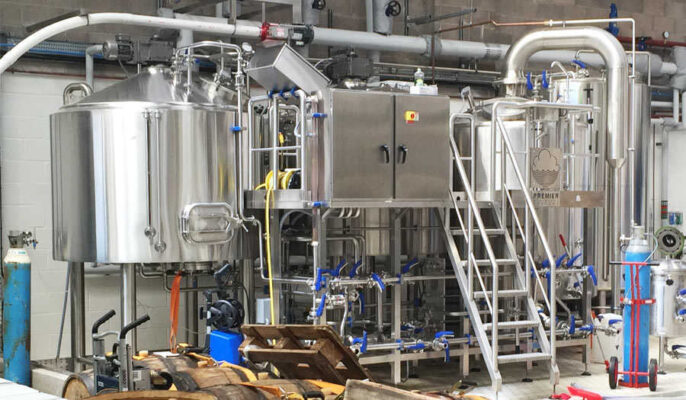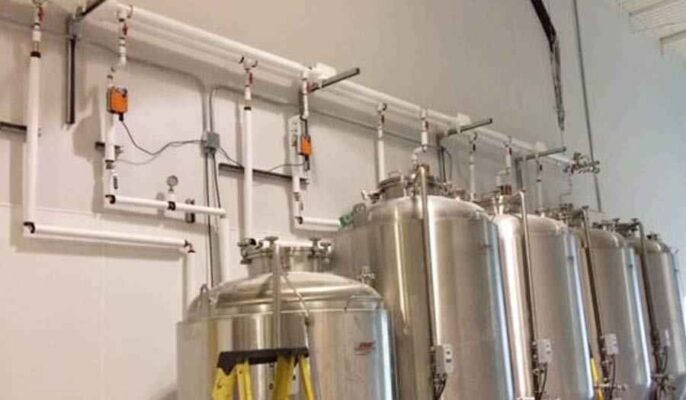최근 몇 년 동안 홈브루잉과 수제 맥주의 인기가 폭발적으로 증가했습니다. 점점 더 많은 사람들이 집에서 직접 맥주를 양조하거나 소규모 양조장을 창업하고 있습니다. 그러나 대규모 상업용 양조 장비는 소규모 생산자에게는 엄청나게 비쌀 수 있습니다.
이 가이드는 다음에 대한 포괄적인 개요를 제공합니다. 스몰비어 양조 장비 홈브루어와 소규모 양조장 스타트업에 적합합니다. 필요한 주요 장비, 유형, 특성, 용도, 사양, 크기, 가격, 설치, 운영, 유지보수 및 공급업체에 대해 다룹니다.
소형 맥주 양조 장비 개요
소규모 맥주 양조 장비를 사용하면 상업용 양조장 장비를 소규모 배치로 축소하여 적은 예산으로 고품질의 맥주를 만들 수 있습니다. 기본적인 양조 과정과 주요 구성 요소는 동일하게 유지됩니다. 이 장비는 식품 등급의 위생을 유지하기 위해 스테인리스 스틸로 제작되었으며 작은 공간에 맞게 조정되었습니다.
스몰비어 양조의 핵심 장비 구성 요소는 다음과 같습니다:
- 매시 툰 - 분쇄한 맥아를 뜨거운 물과 섞어 당분을 추출합니다.
- 로터 튠 - 사용한 곡물에서 달콤한 맥아즙 분리
- 양조 주전자 - 맥아즙과 홉을 함께 끓입니다.
- 발효기 - 달콤한 맥아즙을 맥주로 발효
- 케깅 시스템 - 완성된 맥주 운반 및 보관
펌프, 밸브, 냉각기, 필터 등과 같은 추가 장비가 공정을 자동화합니다. 소규모 양조 장비는 규모, 단순성, 작은 설치 공간, 합리적인 가격으로 차별화됩니다. 각 시스템 구성 요소를 자세히 살펴보겠습니다.
소형 맥주 양조 장비의 종류
생산 목표에 따라 몇 가지 소형 양조 장비 구성이 있습니다:
| 장비 유형 | 배치 크기 | 생산 규모 |
|---|---|---|
| 스타터 브루잉 키트 | 1-5 갤런 | 홈브루잉 |
| 미니 양조장 | 5-7 배럴 | 소규모 양조장 |
| 파일럿 브루잉 시스템 | 7-15 배럴 | 소규모 양조장 |
| 나노 양조장 | 1-3 배럴 | 크래프트 브루펍 |
- 스타터 키트 - 취미로 홈브루잉을 하기 위한 기본 장비
- 미니 양조장 - 맥주 통을 생산하는 소규모 양조장을 위한 수동 장비
- 파일럿 시스템 - 미니 칵테일을 채우는 브루펍을 위한 자동화 기능
- 나노 양조장 - 탭룸을 위한 컴팩트한 플러그 앤 플레이
따라서 나노 및 파일럿 시스템은 상업용 소량 생산을 위해 설계된 반면, 미니 및 스타터 장비는 개인 또는 실험용 양조용입니다.
소형 양조 장비의 특징
소형 양조 장비의 일반적인 특징은 다음과 같습니다:
- 식품 안전과 내식성을 위해 스테인리스 스틸로 제작되었습니다.
- 1~15배럴 용량의 소규모 배치에 최적화되어 있습니다.
- 최소한의 공간만 차지하도록 설계
- 수동 조작 또는 반자동으로 간소화된 설계
- 대형 양조장에 비해 낮은 전력 요구량
- 바퀴가 있어 유연하게 이동할 수 있는 이동성
- 사용자 지정이 가능한 모듈식 구성
- 대규모 시스템에 비해 상대적으로 경제적인 가격
- 소규모 설정에서 더 쉽게 양조 배우기
- 구매 시 포함된 지원 및 교육
- 레시피 또는 양조 기술 연구개발에 적합
- 향후 모듈식 추가를 통해 생산량 확장 가능
따라서 소규모 맥주 제조 장비는 홈 브루어 규모에서 상업적인 품질의 결과를 제공합니다. 비용과 공간이 적게 들기 때문에 소규모 양조장을 시작하기에 안성맞춤입니다.
소규모 맥주 양조장의 애플리케이션
맥주 생산 규모에 따라 장비 선택의 기준이 달라집니다:
| 사용자 | 목적 |
|---|---|
| 홈브루어 | 취미로 5갤런 배치 양조하기 |
| 크래프트 브루어 | 대표 레시피 및 계절별 레시피 개발 |
| 소규모 양조장 | 양조장 또는 시음장 시작하기 |
| 나노 양조장 | 탭룸에서 스페셜티 맥주 제공 |
| 레스토랑 | 현장에서 펍 맥주 만들기 |
| 바 소유자 | 독특한 수제 맥주 제품 |
소규모 맥주 제조 장비를 사용하면 거의 모든 사람이 현장에서 브루마스터가 될 수 있습니다. 다음과 같은 용도로 사용할 수 있습니다:
- 소량으로 새로운 맥주 레시피 테스트
- 탭룸에서 신선한 수제 맥주 제공
- 하우스 브루를 통한 바/레스토랑 서비스 확대
- 지역 마이크로브루어리 브랜드 구축
- 상업용 수제 맥주 양조에 대한 낮은 위험 부담
- 다른 곳에서는 찾아볼 수 없는 독특한 커스텀 브루어리
스타트업의 경우 소규모로 시작하면 규모를 확장하기 전에 양조 기본 사항을 마스터할 수 있습니다.

소규모 맥주 양조 장비 가이드
소규모 양조 시스템의 각 주요 장비 구성 요소의 기능, 유형, 특징 및 크기 고려 사항을 살펴보겠습니다.
매시 툰
매시 툰은 분쇄한 맥아(가루)를 뜨거운 물과 섞어 전분을 발효 가능한 당으로 전환하여 양조용 맥아즙을 만듭니다.
| 유형 | 특징 |
|---|---|
| 단열 용기
잘못된 바닥/파이프 매니폴드 필터 화면 상자 |
스테인리스 스틸(304 또는 316 등급)
홈브루 모델 10-32갤런 프로 모델 15-100갤런 용량 강철 메쉬 또는 구멍이 뚫린 가짜 바닥 곡물 헹굼용 스파지 암 일부 모델의 자동 온도 제어 탈착식 뚜껑 |
매시 툰 크기 선택의 주요 요소:
- 대상 배치 크기
- 원하는 매시 두께를 위한 곡물 대 물 비율
- 공간 제약
- 배치 스파지 또는 연속 스파지 추출 방법
10갤런 양조 용량의 경우, 15~20갤런 튠은 매싱을 위한 충분한 공간을 제공합니다. 나노 배치 크기에는 더 작은 홈브루 매시 툰으로도 충분할 수 있습니다.
라우터 툰
라우터 툰은 매싱 후 달콤한 맥아즙을 곡물에서 분리합니다. 때때로 매시 툰과 결합되기도 합니다.
| 유형 | 특징 |
|---|---|
| 로터 튜닝
림/살포 용기 |
가짜 바닥/파이프가 있는 스테인리스 스틸 용기
곡물 헹굼용 살포 암 맥아즙 수집을 위한 첨부 파일 부여 |
고려 사항
- 매시튠 용량에 따른 튠 크기
- 연속 살포에는 더 큰 용기가 필요합니다.
- 구멍이 뚫린 잘못된 바닥과 메쉬 스크린
- 곡물 바닥 갈퀴 및 교반 메커니즘(옵션)
소규모 양조장의 경우 매시 툰과 라우터 툰을 하나의 용기에 담아 공간과 비용을 절약할 수 있습니다.
양조 주전자
양조 주전자는 맥아즙과 홉을 끓여 풍미, 향, 색을 생성합니다.
| 유형 | 특징 |
|---|---|
| 직화 주전자
스팀 재킷 주전자 |
스테인리스 스틸, 5~30갤런 용량
직접 가스/전기 발열체 |
추출 주전자 크기 고려 사항:
- 용량 결정 시 끓는점 비율 고려
- 더 큰 주전자로 홉 이성질체화를 위해 힘차게 끓일 수 있습니다.
- 스팀 가열로 필스너/라거의 맥아즙을 부드럽게 처리합니다.
- 끓이는 시간이 짧은 대부분의 에일에 적합한 직화 방식입니다.
- 우수한 열유속으로 난방 및 냉방 가속화
나노 양조의 경우 5~10갤런 케틀이면 충분합니다. 더 큰 15~30갤런 시스템을 사용하면 생산량을 늘릴 수 있습니다.
발효기
발효기는 효모가 맥주로 발효하는 동안 냉각된 끓인 맥즙을 저장합니다.
| 유형 | 특징 |
|---|---|
| 원뿔형 발효기
원통형 탱크 유리/PET 카보이 |
5-30갤런 스테인리스 스틸 또는 플라스틱 용기
원추형으로 효모 수확 가능 온도 제어 재킷/프로브 에어록, 포트, 밸브 및 액세서리 |
발효기 선택 시 고려 사항
- 원하는 배치 크기
- 사용 가능한 공간
- 직접 또는 간접 냉각 방식
- 원뿔에서 효모를 수확하는 능력
- 여러 맥주 양조를 위한 발효기 수
- 압력 발효 옵션
홈브루잉의 경우 5갤런 유리병이나 PET 카보이가 적합합니다. 상업용 나노 양조장에서는 7~30배럴 원뿔형 또는 단일 탱크를 사용합니다.
케깅 시스템
케깅 시스템은 완성된 맥주를 맥주통에 간편하게 포장하여 서빙할 수 있습니다.
| 유형 | 특징 |
|---|---|
| 미니 케그 필러
역압 필러 |
위생통 충전용 충전 헤드
이송 중 인라인 탄산 수동 또는 자동 모델 미니 하프 배럴 케그용 사이즈 |
케깅 시스템 요소:
- 산소를 피하기 위한 부드러운 노폼 이송
- 간편한 청소 및 위생
- 추가 필 헤드를 통한 유연한 확장
- 반자동 또는 완전 자동화 시스템
고품질 케깅은 유통기한을 향상시킵니다. 미니 케그 필러를 사용하면 소량 포장도 가능합니다.
추가 양조 장비
소규모 양조장에는 핵심 구성 요소 외에도 엔드투엔드 시스템을 위한 보조 장비가 필요합니다:
- 뜨거운 주류 탱크 – Heats up sparge water separately
- 펌프 – Transfers liquids between vessels
- 맥아즙 냉각기 – Quickly cools boiled wort before fermenting
- 수처리 – Filters and softens brewing water
- Cleaning/sanitation – CIP spray balls, chemicals, tools
- 온도 제어 – Jackets, heater, chillers, thermometers
- 파이핑 – Food-grade hoses, valves, manifolds to connect equipment
- 계측 – Hydrometers, Refractometers to monitor brewing
- 곡물 처리 – Mills, wet bins for managing malt
Automated controls and motors can be added for semi-automated operation. Compact modular systems combine multiple stages in one frame.
소형 맥주 양조 장비 사양
Key specifications to consider when selecting small brewery equipment:
| 매개변수 | Typical Ranges |
|---|---|
| 배치 크기 | 1-7 barrels (bbl) |
| 프로덕션 | 1-15 bbl/batch; 100-500 bbl/year |
| 선박 볼륨 | 10-100 gallons |
| Heating power | 2500-5000 Watts |
| Pumping rate | 5-10 gpm |
| 높이 | 4-10 feet |
| 지름 | 1-3 feet |
| 재료 | Stainless steel (304, 316); food-grade plastic |
| 자동화 | Manual, semi-automatic, automatic |
| 전원 공급 장치 | 120V single phase, 240V 1-3 phase |
| 무게 | 50-500 lbs per vessel |
Nano and pilot equipment have smaller batches and compact footprint than full-sized brewhouses. Manual operation lowers costs for starter breweries.

소규모 양조 시스템 크기 조정
Follow this process when sizing a small beer brewing setup:
- Establish production goals – Desired annual or monthly beer production
- Determine batch size – Batch capacities based on fermenter and kettle sizes
- Calculate brewhouse capacity – Batches per week based on fermentation turnover
- Size vessels – Mash tun, kettle, fermenter volumes for each batch
- Select heating system – Direct fire or steam heating based on output needs
- Choose automation level – Manual, semi or fully automated
- Determine power requirements – Electric, gas, or steam boiler
- Design brewhouse layout – Equipment footprint and headspace
- Plan utilities – Electrical, water, wastewater, ventilation, etc.
- Rightsize components – Pumps, piping, chilling, controls matched to batch sizes
- Estimate costs – Equipment, installation, shipping, other expenses
Start small and leave room to add capacity. A modular approach makes future expansions easier.
소규모 맥주 양조 장비 비용
Prices for small commercial beer brewing equipment typically range:
| 장비 | Typical Price Range |
|---|---|
| 1 barrel pilot brewery | $10,000 - $25,000 |
| 3-7 barrel mini brewery | $50,000 – $150,000 |
| 7-15 barrel microbrewery | $100,000 – $300,000 |
| Additional fermenters | $1,000 – $5,000 each |
| Keg washer/filler | $3,500 – $10,000 |
| 곡물 처리 시스템 | $5,000 - $15,000 |
| 냉각기 | $2,000 – $7,500 |
| 증기 발생기 | $4,000 - $10,000 |
Major cost factors:
- Equipment scale, degree of automation
- Vessel fabrication material (stainless steel versus plastic)
- Direct versus indirect heating method
- New versus reconditioned vessels
- Customization versus pre-engineered systems
For micro startups, going used and manual lowers the initial investment. Quality should not be compromised though.
소규모 맥주 양조 장비 공급업체를 선택하는 방법
Here are tips for choosing a small brewery equipment supplier:
| 고려 사항 | 기준 |
|---|---|
| Range of equipment | Provide full brewhouse capabilities |
| Custom fabrication | Allow custom vessel designs |
| Design expertise | Experienced engineering team |
| 제조 | In-house versus outsourced production |
| Manual versus automated | Offer both manual and automated systems |
| 사용자 지정 | Allow adapting standard equipment |
| Cost options | Good, better, best equipment tiers |
| 확장성 | Modular designs for incremental expansions |
| 리드 타임 | Quick fabrication and delivery |
| 배송 | Coordinated packaging and freight quotes |
| 설치 서비스 | End-to-end setup assistance |
| 문서 | Detail operating procedures, manuals, diagrams |
| 교육 | Provide operator instruction onsite |
| 보증 | At least 1 year workmanship warranty |
| 서비스 가능성 | Responsive post-sale tech support |
| 참조 | Established clientele recommendations |
Selecting the right partner ensures a smooth project execution.
소규모 양조 시스템 비교
There are some key decision points when choosing small commercial brewing equipment:
수동 작업과 자동 작업 비교
| 수동 추출 | 자동 양조 |
|---|---|
| 장비 비용 절감 | Higher upfront cost |
| Simpler startup | Complex programming |
| Less maintenance | Consistent results |
| 노동 집약적 | Less labor for monitoring |
| Viable for microbreweries | For larger nano breweries |
Manual operation works for small craft brewers starting out. Automating improves consistency in larger volumes.
직접 가열과 간접 가열
| Direct Heating | Indirect Heating |
|---|---|
| Gas or electric elements | Steam jackets or coils |
| 장비 비용 절감 | Gentler wort treatment |
| Suitable for most ales | Needed for lagers and pilsners |
| Quick heating and cooling | Slower temp changes |
| Higher risk of scorching | More precise control |
Direct heating with gas or electric elements is common for ales. Steam heating protects delicate lagers.
316 스테인리스 대 304 스테인리스
| 316 Stainless Steel | 304 스테인리스 스틸 |
|---|---|
| More corrosion resistance | Prone to corrosion over time |
| Needed for saltwater environments | Okay for most inland breweries |
| Easier cleaning and passivation | Can harbor bacteria if compromised |
| Longer equipment lifetime | 초기 비용 절감 |
| Better resale value | Still works for short-term |
316 stainless is worth the extra cost for the added corrosion resistance. 304 stainless requires diligent cleaning and maintenance.

소규모 양조장 장비 설치
Proper installation of small beer making equipment ensures safe and efficient operation:
- Review equipment drawings and manuals
- Check for damages and verify dimensions
- Uncrate and clean vessels before installing
- Level and securely anchor all vessels
- Connect vessels per brewery diagrams
- Install valves, piping, pumps and controls
- Wire up electric panels, sensors and motors
- Test run vessels empty before first use
- Passivate and clean freshly installed system
- Adjust, calibrate instruments for accuracy
- Fix leaks, seal connections, recheck alignments
- Startup per manufacturer procedures
- Validate measurements, settings, operation
- Document as-built configuration and SOPs
Taking the time to methodically install the brewhouse prevents headaches down the line.
소형 맥주 양조 장비 운영
Follow good practices when operating small beer brewing equipment:
- Strictly follow all safety procedures
- Monitor brewing process parameters
- Take wort samples and measurements
- Adjust flows, temperatures, times per recipe
- Watch for foaming, leaks, blockages, other issues
- Maintain cleanliness throughout the process
- Record batch details for tweaking recipes
- Transfer wort carefully to avoid aeration
- Sanitize fermenters and yeast as needed
- Control fermentation temperature carefully
- Regularly calibrate instrumentation
- Keep detailed brewing logs for analysis
- Schedule maintenance downtime between batches
Consistent operation brews to brew allows dialing in recipes perfectly.
소규모 맥주 장비 유지보수
Proper maintenance keeps small beer brewing equipment running smoothly:
- Thoroughly clean and sanitize after each use
- Store equipment dried and disassembled
- Periodic inspection of vessels and piping
- Replace worn gaskets, seals and o-rings
- Re-passivate stainless steel as needed
- Calibrate temperature and density meters
- Inspect electrical wiring for damage
- Check for loose fasteners, anchors
- Test relief and check valves
- Monitor pumps and motors for wear
- Repair leaks in vessels, valves, piping immediately
- Keep spare parts like hoses, gaskets on hand
- Follow manufacturer maintenance manuals
- Record repairs and spare parts usage
Preventative maintenance prevents unplanned downtime mid-brew.

자주 묻는 질문
What size brewing equipment do I need?
The batch size depends on your production goals. 1-3 barrel nano breweries work for a small taproom. 5-15 barrel pilot systems allow keg distribution. Size fermenters, kettles, mash tuns to match target batches.
What does a basic 1 barrel brewery cost?
A starter 1 barrel brewery costs $10,000-$25,000. This includes a mash tun, kettle, fermenter, glycol chiller, pumps, piping, controls and accessories. More automation and exotic metals increase costs.
How much space does a 1 barrel brewhouse need?
Allow at least a 10’ x 10’ footprint for a small 1 barrel brewery. Ceiling height should be 10-12’ tall for lifting vessels. Outdoor installations need additional space for weatherproofing.
새 장비를 사야 하나요, 중고 장비를 사야 하나요?
To save money initially, you can buy reconditioned vessels from a commercial brewery upgrading systems. Or sterilize and refurbish dairy tanks. Ensure used equipment is still up to code.
How long does small scale brewing equipment last?
With proper maintenance, small beer making equipment can last 10-15 years. Eventually pumps, seals and valves need replacing. Stainless steel vessels and frames can far outlive that lifespan.
전기적 요구 사항은 무엇인가요?
Depending on the heating method and automation, electrical loads range from 20-150 amps at 120/240V. Steam heating and automated controls need more power. Plan new service or upgrades accordingly.
Can I expand my nano brewery over time?
Yes, a modular design allows adding fermenters, brite tanks, kegging lines incrementally as production increases. Leave space in the brewhouse layout to add vessels and upgrades.
Where can I get help with designing my system?
Experienced brewery engineering firms can help design equipment, floor plans and processes for a new microbrewery based on your vision, budget and goals.
How do I learn how to brew commercially?
Take courses in brewing science and engineering. Get hands-on training from a pro brewer. Join the MBAA. Start on the smallest equipment to learn fundamentals before expanding.



